- Call +44 (0)20 7244 9661
- Log onto your private Digital Workspace
- Update your contact details
- Ask your mobile tutor a question
Welcome to the Digital Social Media Academy
Digital training and Social Media Marketing Strategy workshops for your team
Overview of our courses
- Get in touch
- Sample lectures
- How we train
- Skills assessment
- International courses
- New 2018 training
- Digital acceleration
- Advanced courses
- Online learning
- Digital workshops
- Digital clinics
- Digital audits
- Always-on marketing
Training services
- In-company training
- Executive coaching
- Marketing courses
- Current participants
- Graduate services
- About us
- Case study library
Consultancy and research
Digital Classroom - Supporting resources for Academy participants
Connecting intimately with consumers : Harnessing social media, consumer generated content, social networking and ‘Web 2.0’ trends
Blogs and online communities are just some of the ways to harness social media and ‘user generated content’. The sudden rise of social media has created new publishing and marketing techniques. There are many more publishing tools for getting the most from UGC within your online audience. In this Web 2.0 workshop, we start thinking about the practical side of how to harness social networking and collective intelligence to give your website increased traffic and an editorial edge. We explore different types of UGC and provide practical hints and tips on how brands and website publishers can make their content more easily discoverable to help drive audiences.
Digital Classroom: Questions about social media?
Here's the place to post them. Is there something you did not understand? Is there a new point you would like to make? Are there any new issues that you have discovered now you are applying your knowledge? Use this space to make your comments and to ask your questions.
Try to include the title of the topic discussed during the keynote that your question relates to (if there is one). Putting this at the start will help other participants find the topics they are interested in.
The classroom is open for one month and materials will stay here as a reference point for you for a further year.
Digital Insight Report: 10 Golden Rules in Social Media Marketing
Social media marketing best practice

Blogs, online communities, social media and then social networks: they have permanently changed online marketing. In this new landscape brands are in a constant dialogue with customers who increasingly play critical roles in advocacy and recommendation. The brand is only one guest among millions and the challenge for marketers is that while the rewards may be great, the risks are greater. The Ten Golden Rules were extracted from analysing the successes and failures of hundreds of social media marketing campaigns, looking for DNA that was shared between the successful and absent in those that failed. The clarity of patterns that emerged removes much of the mystery of social media and helps marketing teams quickly identify the specific risks and potential of the opportunities unfolding around them.
3 Fast Tips for maximizing the value of Twitter
 1. What to Tweet?
1. What to Tweet?
Keep tweets short with less than 100 characters. Include links to content and use hashtags (but not more than 2 in a tweet). Include images using common twitter image hosting platforms and if you want people to retweet what you post then don’t be afraid of asking them. Spelling out retweet is more effective than using the abbreviation RT.
2. When to Tweet?
Generally tweets posted at weekends between 8am-7pm get the highest level of interaction and engagement, but it does vary slightly by industry. Mid-week is almost always the lowest point for engagement.
3. How often to Tweet?
Ideally a brand should tweet regularly. 1-2 a day is a good guide if you are planning on tweeting most days of the week. 4 tweets in a day should be seen as an absolute maximum.
Download more handy tips, here.
These tips are based on research carried out by Buddy Media and Booz & Co based on data from December 2011 to February 2012.
Examples: The first election won with social media?
 The US elections were a defining moment for the use of social media in politics. The Obama campaign generated a massive stream of motivating, engaging content that they successfully distributed across email, social media platforms and their own websites. This formed a turning point in how governments communicate with their citizens.
The US elections were a defining moment for the use of social media in politics. The Obama campaign generated a massive stream of motivating, engaging content that they successfully distributed across email, social media platforms and their own websites. This formed a turning point in how governments communicate with their citizens.
Obama on MySpace | Obama on You Tube
Continue reading "Examples: The first election won with social media?" »
Digital Thought Leaders
At this social media event we bring together four of the leading media and social media brands. Facebook has just celebrated its fifth birthday and is now one of the largest websites in the world, YouTube (now part of Google) pioneered online video content and created a step-change in the role of the web, Reuters is the most well respected news gathering operation in the world and is weaving Twitter into its marketing plans, and the BBC is the country’s largest media and entertainments website. All have found different ways to harness social media, and here you can meet the people driving their plans. Find out more about the people and see what they said about how brands can harness social media.
About Digital Training Academy courses and marketing coaching
- How does our digital marketing coaching and training work? Here is a quick overview… Welcome to your academy
- Which countries do we train in? We are based in the UK but train in twenty countries, in the Americas, Asia, Africa, Middle East and across Europe, including these… Directory of international Digital Classrooms
- Where in the world are we next month? Here is a list of a few events… Events @ Digital
- What research will you get after training? Here are some examples of the monthly digest of research and reports you will receive for one year.
- Would you like to see an example online classroom? Here is one from the Digital Search Academy.
- Would you like to see an example of how tutors answer marketing questions after your training? Here’s an example from the Digital Publishing Strategy Academy.
- Would you like to see an example of an international classroom? Here is one from Croatia, the smallest market we train in.
- Would you like to see an example of a lesson? Here is one from the Digital Analytics Academy that was videoed.
- What did Academy graduates say about their training? Here are just a few of the comments… Testimonials.
- Do we deliver executive coaching for Chief Executives and boards of directors? Yes, we can talk more by email.
- Do we train advertising agencies, and digital agencies? Yes, we can talk more by email.
- If there are only a couple of people who need training, would you like to join a public course? Public Access Courses
Executive and Leadership Academy programmes for coaching senior teams
For ten years we’ve developed insight and coaching programmes to give senior teams the edge their brands and websites needed. We blend marketing and communications strategy with digital insights to build smarter models for engagement and more successful sales for brands. Our consultants have been leading industry thinking since and some have been coaching senior management in digital media and marketing for 15 years. Based in London, our teams have worked in 30 countries, and across dozens of sectors to match the complex needs the brands we support.
Get in touch email TheTeam@DigitalStrategyConsulting.com | Coaching leadership teams | International coaching programmes in digital publishing and online marketing
Pinterest marketing tips
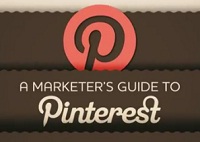
Looking to use Pinterest in your marketing? Here are a few Pinterest marketing tips to get you going. These introductory films that are a great introduction to how Pinterest works for marketing. The rapid growth in audiences on the Pinterest social network has made it an attractive channel for marketers – initially in the US and now in dozens of markets. Pinterest is proving strong at referring qualified traffic to brands, and the design is inherently linked to ecommerce opportunities – far more than Twitter or Facebook at the equivalent stage in their development.
Digital Toolkit | Creating expert reviews
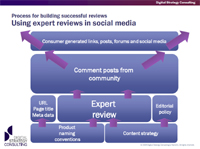 Getting social media right is challenging. Many blogs go unread, many forums remain silent and many brand managers waste their time and budget by focusing energy in the wrong direction. Harnessing consumer involvement in product reviews demands understanding the nature of participation and having the right approach to content. Expert reviews should be at the heart of content strategies that rely on translating consumer comments into something meaningful for others to review. These social media strategy notes provide a simple template for getting the right framework in place for expert reviews. Around the expert reviews, simpler participation such as ratings, tag clouds, reviewer ratings and secondary consumer comments can easily be incorporated.
Getting social media right is challenging. Many blogs go unread, many forums remain silent and many brand managers waste their time and budget by focusing energy in the wrong direction. Harnessing consumer involvement in product reviews demands understanding the nature of participation and having the right approach to content. Expert reviews should be at the heart of content strategies that rely on translating consumer comments into something meaningful for others to review. These social media strategy notes provide a simple template for getting the right framework in place for expert reviews. Around the expert reviews, simpler participation such as ratings, tag clouds, reviewer ratings and secondary consumer comments can easily be incorporated.
Best practice | 10 golden rules for getting social media right
Social media, social networks, blogs and online communities have permanently changed online marketing. In this new landscape brands are in a constant dialogue with customers who increasingly play critical roles in advocacy and recommendation. The challenge for marketers is that while the rewards may be rich, the risks are greater. Their brand is just one guest among millions, and nobody is in control. These 10 golden rules grew from training brands on social media marketing across the UK, Europe, Asia and Latin America. Consistently the same patterns emerged: the brands that failed followed few of these approaches, the brands that succeeded had most in place.
Social media research and statistics: Digital Intelligence - Tracking the growth of social media
Here you can find examples of social media research from the last two years with graphs of audience growth for Facebook, Myspace, Twitter and other key social media brands.
- Twitter revenue model: 2.0?
- LinkedIn passes 40m member mark
- Facebook signs up 200m users
- Social networks and blogs eclipse email
- Facebook becomes UK's most searched for brand
- 74% of Europeans use social networking sites
- Social network audience reaches 80m in US
- Facebook swells to over 150m users
- All social media research and stories
Social media marketing issues: keynote debate at Technology for Marketing (UK)
 For the third year running, Danny Meadows-Klue keynoted at the Technology for Marketing congress and this video from one of the attendees captures some of the ideas and atmosphere. Danny invited YouTube, Facebook, Reuters and the BBC to join him to debate what best-practice means in social media marketing and took questions from participants online during the previous two weeks through the Social Media Marketing Academy pages on the supporting website.
For the third year running, Danny Meadows-Klue keynoted at the Technology for Marketing congress and this video from one of the attendees captures some of the ideas and atmosphere. Danny invited YouTube, Facebook, Reuters and the BBC to join him to debate what best-practice means in social media marketing and took questions from participants online during the previous two weeks through the Social Media Marketing Academy pages on the supporting website.
Watch the video of the debate | Social media marketing best practice: Download the 10 Golden Rules for Social Media Marketing
Continue reading "Social media marketing issues: keynote debate at Technology for Marketing (UK)" »
Lecture notes: Download
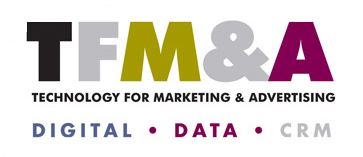 Bookmark this page and look out for the downloads coming soon. We’re editing together Danny’s slides from the recent lecture about social media.
Bookmark this page and look out for the downloads coming soon. We’re editing together Danny’s slides from the recent lecture about social media.
Because 1200 people who applied couldn’t join our session in February (due to the fire capacity) we’ve set up additional small scale workshops of our own here in London in March. Places are limited, and priority goes to TFM&A delegates. 50% discount: We know lots of people travelled to see the session, and the event organisers apologised about the limited places, and that’s why we want to give TFM&A delegates a 50% discount, reducing the full day price to £395+vat.
Social networking forum – finding out more about what smart social networking is all about
Olympia Conference Hall, London | Monday 9th/Tuesday 10th March: 10:00 - 18:00
 Keeping on top of the latest trends in social networking is a constant challenge. No sooner have you started building an application on Facebook than people want to be your fans. Just when that corporate blog is ready for the next update you find half your office are already on Twitter. From MySpace and Bebo, to the pioneers at AOL and Yahoo, social media presents a daunting array of choices for marketers.
Keeping on top of the latest trends in social networking is a constant challenge. No sooner have you started building an application on Facebook than people want to be your fans. Just when that corporate blog is ready for the next update you find half your office are already on Twitter. From MySpace and Bebo, to the pioneers at AOL and Yahoo, social media presents a daunting array of choices for marketers.
Enter the Social Networking World Forum, and a rare chance to see the people you need to under one roof in either London, California or Singapore. They’re high level conference and seminars looks set to deliver some of the latest thinking to brand managers from firms large and small.
Join the Digital Training Academy team by dropping by to meet Claire, Peter and more of the team. And if you miss our Ten Golden Rules, then there are free places for several delegates to the show at our social media marketing breakfast in London on Friday.
Social networking map
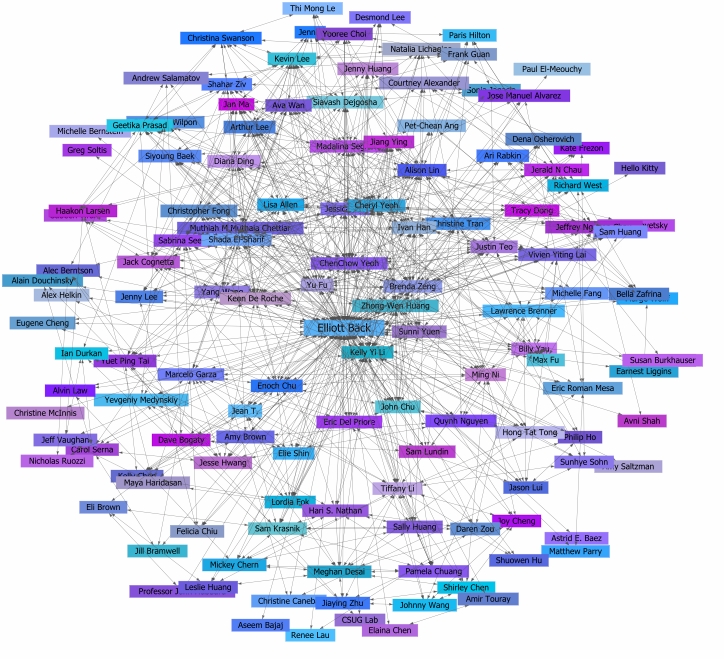
Social networks: A first step towards European regulation
European regulators unveiled long anticipated plans this week for guidelines about how social networks such as Facebook and MySpace should handle European privacy rules, writes the Wall Street Journal. Regulation in a young and fast changing space is always risky, and many will argue lacks necessity because of the existing data protection directive. However the guidelines appear to have been set very low, simply reconfirming what would be common knowledge even for novice internet users.
Continue reading "Social networks: A first step towards European regulation " »
Social media: Domino's Pizza - crisis management response
Social media can deeply damage brands - whether they're running social campaigns or not. When two Domino's Pizza employees contaminated food and released and unpleasant video onto YouTube bragging about their misbehavings, it triggered a mass outcry. Every large organsiation faces control challenges, but the quick response with a CEO video apology and management changes shows many aspects of best practice.
Continue reading "Social media: Domino's Pizza - crisis management response" »
Case studies: Brands that fail - Habitat’s social media blunder and Twitter spam | Sector: Retail | Format: Social Media
 The Habitat furniture store is among many brands to have misunderstood Twitter, blundering in to a private social space with typically offline approach. Their clumsy attempt to use Twitter’s # tags was an ill thought through way to get their messaging seen by larger numbers of people. The feed from HabitatUK effectively spammed thousands of people by trying to hijack key trending topics. Hash tags help people track conversations in Twitter, and the retailer decided in June to align itself to topics such as Apple’s iphone and the Iranian elections. It suggests three sequential failures in the marketing strategy: failing to read the landscape and the way people use the tools, failing to create a digitally native strategy and failing to have management checks and controls in place to identify poor practice. Coaching the marcomms team in digital marketing would have prevented this and a clear social media policy would ensure it never happens again.
The Habitat furniture store is among many brands to have misunderstood Twitter, blundering in to a private social space with typically offline approach. Their clumsy attempt to use Twitter’s # tags was an ill thought through way to get their messaging seen by larger numbers of people. The feed from HabitatUK effectively spammed thousands of people by trying to hijack key trending topics. Hash tags help people track conversations in Twitter, and the retailer decided in June to align itself to topics such as Apple’s iphone and the Iranian elections. It suggests three sequential failures in the marketing strategy: failing to read the landscape and the way people use the tools, failing to create a digitally native strategy and failing to have management checks and controls in place to identify poor practice. Coaching the marcomms team in digital marketing would have prevented this and a clear social media policy would ensure it never happens again.
Best practice | Marketing on Facebook to fans - some guiding principles for consumer brands
 In the social space, it's not how loud you shout that counts, but how much we want to listen. Many brands have been asking for advice about Facebook updates and how to talk with fans on Facebook. If you're new to social media marketing then here are a few tips to get you started...
In the social space, it's not how loud you shout that counts, but how much we want to listen. Many brands have been asking for advice about Facebook updates and how to talk with fans on Facebook. If you're new to social media marketing then here are a few tips to get you started...
- Respect us as friends;
- Treat us as smart;
- Share things that give value;
- Talk when you've something to say;
- Don't feel the need to fill silences; ... and remember the more interesting you are, the more we'll listen.
Case study: Nokia on Facebook | Sector: Telecommunications | Format: Sponsorship and content integration
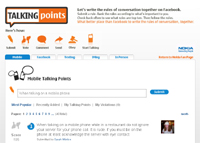 Nokia is about connecting people. The pioneers of mobile phones created the handsets a generation grew up with, and the handsets a generation learned to ‘talk’ with. So how smart and how fitting that Nokia is the brand behind an initiative for writing the rules for mobile and SMS conversations. Getting the most from a new technology isn’t about understanding the functions it’s about understanding how to behave with it. We master the functions quickly, but the behaviour takes longer and as people try out new technologies (from texting to tweeting), there’s a new type of behaviour we have to discover. So when Nokia started thinking about how people connect, it seemed only natural to let their customers do the talking. And that’s what you have right here. A great example of a wider social message, linked to a brand truth, delivered through a sponsorship, inside a community space, using social content - and along the way some great marketing. Like the strapline says, Nokia really are about ‘connecting people’.
Nokia is about connecting people. The pioneers of mobile phones created the handsets a generation grew up with, and the handsets a generation learned to ‘talk’ with. So how smart and how fitting that Nokia is the brand behind an initiative for writing the rules for mobile and SMS conversations. Getting the most from a new technology isn’t about understanding the functions it’s about understanding how to behave with it. We master the functions quickly, but the behaviour takes longer and as people try out new technologies (from texting to tweeting), there’s a new type of behaviour we have to discover. So when Nokia started thinking about how people connect, it seemed only natural to let their customers do the talking. And that’s what you have right here. A great example of a wider social message, linked to a brand truth, delivered through a sponsorship, inside a community space, using social content - and along the way some great marketing. Like the strapline says, Nokia really are about ‘connecting people’.
Case study: Friends of the Earth | Sector: Charity | Format: Social media
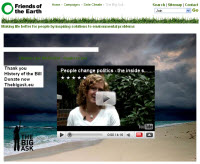 Social marketing has found its new home on the web. The scope for innovation in this sector’s communications is massive, and this campaign caught the mood of the nation and accelerated both cultural and political change. Friends of the Earth found a way anyone could take part in registering their concerns about climate change and their protest over political inactivity. The approach widened participation and created a model now extended across Europe, mobilising people in the way that fits with today’s culture. A brilliant idea executed in a way that is digitally native.
Social marketing has found its new home on the web. The scope for innovation in this sector’s communications is massive, and this campaign caught the mood of the nation and accelerated both cultural and political change. Friends of the Earth found a way anyone could take part in registering their concerns about climate change and their protest over political inactivity. The approach widened participation and created a model now extended across Europe, mobilising people in the way that fits with today’s culture. A brilliant idea executed in a way that is digitally native.
Campaign website | Watch the video
Continue reading "Case study: Friends of the Earth | Sector: Charity | Format: Social media" »
Case study: Talk Talk | Sector: Telecoms | Format: Social Media
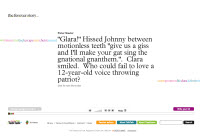 A brilliant example of taking a big idea and applying it online. Using the web as a platform for engagement, Talk Talk aligned with the Treehouse autism charity to create The Forever Story, persuading thousands of consumers to take part and collaborate in what became a Guinness world record for the largest multi-author story ever: 8000 entries, 20 hours of content, podcasts, Facebook apps - and of course, the story continues, online.
A brilliant example of taking a big idea and applying it online. Using the web as a platform for engagement, Talk Talk aligned with the Treehouse autism charity to create The Forever Story, persuading thousands of consumers to take part and collaborate in what became a Guinness world record for the largest multi-author story ever: 8000 entries, 20 hours of content, podcasts, Facebook apps - and of course, the story continues, online.
View case study | Watch the case study video | www.theforeverstory.com
Continue reading "Case study: Talk Talk | Sector: Telecoms | Format: Social Media" »
Case study: Nestle tweets in online ads | Sector: FMCG | Format: Banner adverts, Social media on Twitter
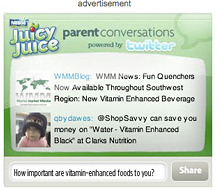 Food manufacturing giant Nestle has come up with an innovative use for Twitter that combines together a mix of digital channels. Their latest advertising campaign for JuicyJuice includes a Twitter feed within the advertising creative. This social media campaign lets people post their own tweets within the advertising that appears online. At the time of writing, the brand is testing it on US sites CafeMom and BabyCenter. Here’s how it works: there are questions inside the advertising space that relate to parenting (How do you stimulate your child's mind? How important are vitamin-enhanced foods to you?). People can write their message or tweet inside the advertising.
Food manufacturing giant Nestle has come up with an innovative use for Twitter that combines together a mix of digital channels. Their latest advertising campaign for JuicyJuice includes a Twitter feed within the advertising creative. This social media campaign lets people post their own tweets within the advertising that appears online. At the time of writing, the brand is testing it on US sites CafeMom and BabyCenter. Here’s how it works: there are questions inside the advertising space that relate to parenting (How do you stimulate your child's mind? How important are vitamin-enhanced foods to you?). People can write their message or tweet inside the advertising.
Case study: RAW cola from Pepsi | Sector: FMCG | Format: Integrated social media and sampling
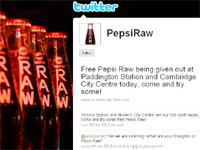 The Pepsi brand in the UK was lacking energy and edge. The distributors Britvic opted for an integrated social media campaign that combined sampling, coupon redemption, in-store promotion and the Twitter social media platform. They used a traditional sampling approach of branded street vendors in high traffic areas that matched with good concentrations of the target demographic. The sampling was combined with giving out vouchers for a price promotion that could be redeemed with a single supporting retailer. And the social media came in the form of on-pack branding and a call to action for people to share their opinions at twitter.com/pepsiraw This is one of the first major integrated FMCG promotions to harness the microblogging application Twitter, and the website tool plays two key roles. The site is the latest zeitgeisty tool that reflects well on the brand by simply being there, but more importantly social media users are the typical early adopters and trendsetters Pepsi needs to gain leverage in the market.
The Pepsi brand in the UK was lacking energy and edge. The distributors Britvic opted for an integrated social media campaign that combined sampling, coupon redemption, in-store promotion and the Twitter social media platform. They used a traditional sampling approach of branded street vendors in high traffic areas that matched with good concentrations of the target demographic. The sampling was combined with giving out vouchers for a price promotion that could be redeemed with a single supporting retailer. And the social media came in the form of on-pack branding and a call to action for people to share their opinions at twitter.com/pepsiraw This is one of the first major integrated FMCG promotions to harness the microblogging application Twitter, and the website tool plays two key roles. The site is the latest zeitgeisty tool that reflects well on the brand by simply being there, but more importantly social media users are the typical early adopters and trendsetters Pepsi needs to gain leverage in the market.
Case study: National Geographic & MySpace Brazil | Sector: Media | Format: Social media
 Here’s a great example of how leading social media brand MySpace linked up with the National Geographic magazine. Click on the links to watch a slideshow case study and follow through to our interview with the MySpace Brazil Vice President when we were coaching marketers in Latin America.
Here’s a great example of how leading social media brand MySpace linked up with the National Geographic magazine. Click on the links to watch a slideshow case study and follow through to our interview with the MySpace Brazil Vice President when we were coaching marketers in Latin America.
Watch case study seminar | Read our interview with the Vice President of MySpace
Case study: Stride chewing gum & Where is Matt? | Sector: FMCG | Format: video, viral
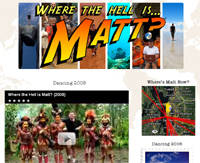 Matt Harding is back, and Striding with friends. The cult following of Matt got a boost when chewing gum brand Stride sponsored his next round-the-world adventure. With a few million views online, Matt had a couple of friends who wanted to take part as well. From Quebec to Los Angeles, Paris to Sao Paulo, Mumbai to Madrid , they showed up and in his words, 'danced badly' with him.
Matt Harding is back, and Striding with friends. The cult following of Matt got a boost when chewing gum brand Stride sponsored his next round-the-world adventure. With a few million views online, Matt had a couple of friends who wanted to take part as well. From Quebec to Los Angeles, Paris to Sao Paulo, Mumbai to Madrid , they showed up and in his words, 'danced badly' with him.
Case study: BMW Films | Sector: Automotive | Format: Video, viral, microsite
The multi award-winning BMW Films project was one of those rare moments when an advertising campaign is so powerful it succeeds in changing the medium it works within. High budget, all-action and with blockbusting stars like Madonna under the stewardship of A-list directors like Ang Lee, the movies were an instant cult success. They showcased the best in movie-making, and delivered it in the context of a message of brand association BMW had carefully crafted. By creating compelling media they generated their own self-selecting audiences without the need of heavyweight media spend.
Continue reading "Case study: BMW Films | Sector: Automotive | Format: Video, viral, microsite" »
Case study: Coca-Cola fan page | Sector: FMCG | Format: Social media, video and viral
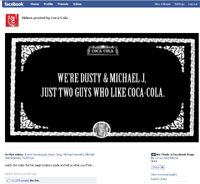 Coca-Cola enjoys the largest audience of any consumer product ‘fan’ page on Facebook. They achieved an authenticity in the style and tone of the content by supporting consumers who created the page, rather than leading on it within the brand team.
Coca-Cola enjoys the largest audience of any consumer product ‘fan’ page on Facebook. They achieved an authenticity in the style and tone of the content by supporting consumers who created the page, rather than leading on it within the brand team.
Case study: Nokia Xpressmusic Brazil | Sector: Telecomms | Format: Social media
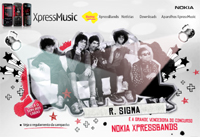 The XpressMusic contest’s featured profile was promoted on MySpace, and supported with ad units clicking through to the profile. The submission phase was promoted heavily with roadblocks, and in all MySpace targeted to bands. Each phase was announced via ad placements throughout the site with refreshed creatives for each phase and bulletins posted from the contest page with appropriate calls to action.
The XpressMusic contest’s featured profile was promoted on MySpace, and supported with ad units clicking through to the profile. The submission phase was promoted heavily with roadblocks, and in all MySpace targeted to bands. Each phase was announced via ad placements throughout the site with refreshed creatives for each phase and bulletins posted from the contest page with appropriate calls to action.
Case study: T-Mobile Life’s for sharing | Sector: Telecommunications | Format: Television, video, viral and social media
 A big idea, executed beautifully. This approach of taking the idea of a flash mob, and the connections between people, and turning it into a massive entertainment experience is a powerful way to communicate the brand values and the consumer benefit of the operator. Mobile operators have real challenges in differentiation, so this type of brand building activity can be fundamental for setting the framework through which consumers see the sector. T-Mobile began the campaign with heavyweight media exposure to build reach and frequency of the video. They extended the campaign across social media and their own media channels, supported with PR and strong online discussion.
A big idea, executed beautifully. This approach of taking the idea of a flash mob, and the connections between people, and turning it into a massive entertainment experience is a powerful way to communicate the brand values and the consumer benefit of the operator. Mobile operators have real challenges in differentiation, so this type of brand building activity can be fundamental for setting the framework through which consumers see the sector. T-Mobile began the campaign with heavyweight media exposure to build reach and frequency of the video. They extended the campaign across social media and their own media channels, supported with PR and strong online discussion.
Case study: Mentos & Diet Coke | Sector: FMCG | Format: Viral
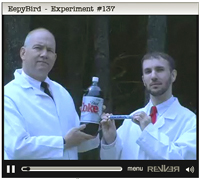 A mint, a fizzy drink and a schoolboy prank taken to extremes. We must have watched this 50 times and still it gets a smile. These videos with quality production values and good direction tell a story that’s right in tone, length and format for the web today. Thanks to YouTube they’ll be around 10 years from now and still reinforcing the brand. But as a creative concept this wasn’t created by the brands; it grew from the street and wasn’t easy for the brands to accommodate at first. What many marketers forget is that for every firm there are brand adorers and brand vandals and there needs to be a strategy for dealing with both. Over the next 10 years the centre of gravity of the web will shift to social media and firms need to have these strategies in place before their brands and content start being used. Marketing in social media demands creating material people want to share. The principles of getting this right grew from the early days of viral marketing in the mid 90s and are closely related to PR. ‘Enjoy the film.
A mint, a fizzy drink and a schoolboy prank taken to extremes. We must have watched this 50 times and still it gets a smile. These videos with quality production values and good direction tell a story that’s right in tone, length and format for the web today. Thanks to YouTube they’ll be around 10 years from now and still reinforcing the brand. But as a creative concept this wasn’t created by the brands; it grew from the street and wasn’t easy for the brands to accommodate at first. What many marketers forget is that for every firm there are brand adorers and brand vandals and there needs to be a strategy for dealing with both. Over the next 10 years the centre of gravity of the web will shift to social media and firms need to have these strategies in place before their brands and content start being used. Marketing in social media demands creating material people want to share. The principles of getting this right grew from the early days of viral marketing in the mid 90s and are closely related to PR. ‘Enjoy the film.
Continue reading "Case study: Mentos & Diet Coke | Sector: FMCG | Format: Viral" »
Case study: Dreyers Dibs | Sector: FMCG | Format: Social media, Microsite, Video
 To promote the launch of Dibs, a new, bite-sized treat from Dreyer’s Ice Cream, Dreyer’s appointed Tracey Locke, ID Society, and MTV Networks Digital Fusion to develop a cross-platform marketing campaign to promote and build brand identity for the product. In addition to on-air promotions, Dreyer’s wanted to drive traffic to an online community where Dibs fans could creatively express their love for the new treat in a contest called the Dibs Bite-Sized Film Fest.
To promote the launch of Dibs, a new, bite-sized treat from Dreyer’s Ice Cream, Dreyer’s appointed Tracey Locke, ID Society, and MTV Networks Digital Fusion to develop a cross-platform marketing campaign to promote and build brand identity for the product. In addition to on-air promotions, Dreyer’s wanted to drive traffic to an online community where Dibs fans could creatively express their love for the new treat in a contest called the Dibs Bite-Sized Film Fest.
Case study: Blendtec | Sector: Consumer electronics | Format: Video, microsite and viral
 How do you make kitchen electricals sexy? Take some heavyweight appliances, a heap of schoolboy mischief, a chef in a white coat, a sprinkle of viral marketing and a splash of social media; then pour the contents into a blender and watch the ingredients bond together to create the perfect recipe for viral marketing. WillItBlend has become legendary in less than six months. It’s made Tom a superstar, transformed a parochial firm into a global brand and boosted sales of $800 smoothie makers. Few firms have the nerve, vision, guts or raw creativity to try this; but when you get the formula right, the results taste awesome.
How do you make kitchen electricals sexy? Take some heavyweight appliances, a heap of schoolboy mischief, a chef in a white coat, a sprinkle of viral marketing and a splash of social media; then pour the contents into a blender and watch the ingredients bond together to create the perfect recipe for viral marketing. WillItBlend has become legendary in less than six months. It’s made Tom a superstar, transformed a parochial firm into a global brand and boosted sales of $800 smoothie makers. Few firms have the nerve, vision, guts or raw creativity to try this; but when you get the formula right, the results taste awesome.
Case study: Skittles | Sector: FMCG | Format: Social media on Facebook
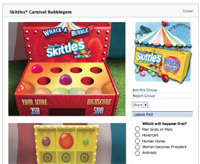 Skittles wanted to introduce and raise brand awareness for its new Carnival Gum confectionery product to teenagers and young adults on Facebook.
Skittles wanted to introduce and raise brand awareness for its new Carnival Gum confectionery product to teenagers and young adults on Facebook.
Skittles leveraged Facebook’s integrated advertising platform to build brand awareness for the new Carnival Gum using a combination of Virtual Gifts, Sponsored Stories and the custom Skittles Carnival Gum Sponsored Group branded destination.
Case study: Sears | Sector: Retail | Format: Social media, website
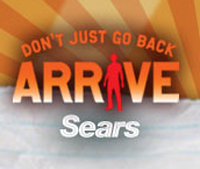 WhittmanHart Interactive needed to launch a two-month campaign for their client, Sears, which would introduce kids to Sears’ latest line of back-to-school clothes. A social media site would tap popular celebrity and style icons, such as High School Musical’s Vanessa Hudgens and rapper LL Cool J, to promote Sears’ clothing lines in a video shoot and encourage kids to engage with the online content and purchase clothes featured in the shoot. This provided a unique Web 2.0 shopping experience for youth consumers.
WhittmanHart Interactive needed to launch a two-month campaign for their client, Sears, which would introduce kids to Sears’ latest line of back-to-school clothes. A social media site would tap popular celebrity and style icons, such as High School Musical’s Vanessa Hudgens and rapper LL Cool J, to promote Sears’ clothing lines in a video shoot and encourage kids to engage with the online content and purchase clothes featured in the shoot. This provided a unique Web 2.0 shopping experience for youth consumers.
Case study: Dove 'onslaught' | Sector: FMCG | Format: Video
 The marketing model behind this campaign involves using video as a way to deliver a powerful message that's in tune with the beliefs of the target consumer. The brand is creating powerful content that it releases online in a way intended to be stumbled upon by consumers and shared between their friends. By releasing it to open platforms such as YouTube, they're implicitly inviting discussion. There can be paid-for placement in key media to extend the reach and start the process, but ideally the campaign works by the word of mouth effect. To gain accountability the brand team can track play rates to measure the number of exposures, and use qualitative and social network analysis to gain feedback about the brand sentiment.
The marketing model behind this campaign involves using video as a way to deliver a powerful message that's in tune with the beliefs of the target consumer. The brand is creating powerful content that it releases online in a way intended to be stumbled upon by consumers and shared between their friends. By releasing it to open platforms such as YouTube, they're implicitly inviting discussion. There can be paid-for placement in key media to extend the reach and start the process, but ideally the campaign works by the word of mouth effect. To gain accountability the brand team can track play rates to measure the number of exposures, and use qualitative and social network analysis to gain feedback about the brand sentiment.
Continue reading "Case study: Dove 'onslaught' | Sector: FMCG | Format: Video" »
Case study: Rocksound | Sector: Publishing | Format: Social media on Twitter
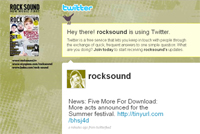 A rock magazine for 15-24 year olds has a naturally good fit with the profile of early adopting techno-heads. But that doesn’t mean their management team would know how to engage in the digital space or have the innovative spirit to try things out. But they do, they did, and here’s the result. It’s a great example of low cost digital publishing with the content driving brand adorers to build buzz about their passions and discussion about the brand.
A rock magazine for 15-24 year olds has a naturally good fit with the profile of early adopting techno-heads. But that doesn’t mean their management team would know how to engage in the digital space or have the innovative spirit to try things out. But they do, they did, and here’s the result. It’s a great example of low cost digital publishing with the content driving brand adorers to build buzz about their passions and discussion about the brand.
Case study: Sprite | Sector: FMCG | Format: Video and viral
![]() Viral can deliver exceptional impact on brand image and consumer engagement, but as a marketing tool it remains unpredictable and highly challenging to get right. Viral is an effect rather than a media channel. Brands don't create virals - they simple create the content. What happens next is up to consumers. While one in a thousand campaigns may gain real traction, the majority of web marketing is either not arresting enough or motivating enough to earn a viral effect. However, for the brands that get it right, viral can deliver complex brand messages and generate fast distribution among both the mass market and niche audiences. Against a landscape of media saturation they can achieve cut-through because they arrive with consumers through the endorsement of their friends. Planners can use the viral effect particularly well to pass messages through communities that otherwise are hard to pin down. If those audiences don't naturally come together around online media content then there may be no way of reaching them through conventional web advertising approaches. The viral effect inside a community can ensure the message finds the people who are most receptive.
Viral can deliver exceptional impact on brand image and consumer engagement, but as a marketing tool it remains unpredictable and highly challenging to get right. Viral is an effect rather than a media channel. Brands don't create virals - they simple create the content. What happens next is up to consumers. While one in a thousand campaigns may gain real traction, the majority of web marketing is either not arresting enough or motivating enough to earn a viral effect. However, for the brands that get it right, viral can deliver complex brand messages and generate fast distribution among both the mass market and niche audiences. Against a landscape of media saturation they can achieve cut-through because they arrive with consumers through the endorsement of their friends. Planners can use the viral effect particularly well to pass messages through communities that otherwise are hard to pin down. If those audiences don't naturally come together around online media content then there may be no way of reaching them through conventional web advertising approaches. The viral effect inside a community can ensure the message finds the people who are most receptive.
Viral messaging can also extend the period a campaign is in market because it continues to live long after a paid for advertising campaign has passed. Viral marketing can self-select its audience and in the hands of an experienced planner, the half-life of a campaign can betracked and anticipated
Continue reading "Case study: Sprite | Sector: FMCG | Format: Video and viral" »
Case study: STA Travel and Off Exploring | Sector: Travel | Format: Website & platform
 This pioneering use of blogging by the STA travel business found a way of engaging hundreds of thousands of customers. Rather than creating a corporate blog, STA worked with the technology team at Off Exploring to build a powerful platform their customers could use. They gave the customers of their travel services a blog and by doing this connected together an online community of like-minded individuals. Customers were encouraged to tell the story of their travels, building content and emailing their friends. Instantly the technology was a success, with backpackers writing their letters home to friends and family in the form of web pages that could instantly be linked to from Facebook and other social media. It's a rare example of pioneering social media because it went against the conventions at the time it was created. The technologists at Off Exploring created the framework for this social media platform and then continued to add more tools to it. As consumers are more exposed to different forms of advertising (and in ever-increasing amounts), brands need to listen carefully to what they want: providing the right tools and utility assures cut-through in an increasingly cluttered market.
This pioneering use of blogging by the STA travel business found a way of engaging hundreds of thousands of customers. Rather than creating a corporate blog, STA worked with the technology team at Off Exploring to build a powerful platform their customers could use. They gave the customers of their travel services a blog and by doing this connected together an online community of like-minded individuals. Customers were encouraged to tell the story of their travels, building content and emailing their friends. Instantly the technology was a success, with backpackers writing their letters home to friends and family in the form of web pages that could instantly be linked to from Facebook and other social media. It's a rare example of pioneering social media because it went against the conventions at the time it was created. The technologists at Off Exploring created the framework for this social media platform and then continued to add more tools to it. As consumers are more exposed to different forms of advertising (and in ever-increasing amounts), brands need to listen carefully to what they want: providing the right tools and utility assures cut-through in an increasingly cluttered market.
Download_STA_Travel_case_study | Off Exploring technology platform | STA Travel
Case study: Coke - Grand Theft Auto | Sector: FMCG | Format: Video and viral
 This television style commercial uses the classic tease and reveal model. It builds a story which is entertaining and engaging. By releasing it on line the web Coke build discussion among key target audiences. The fact the origins of the idea are in an online game gives a synergy with the target audience and the viewing environment. The creative is really a classic television commercial that simply takes an icon of the digital gaming world – Grand Theft Auto – and builds a story around it. The way it was deployed then created a greater effect...
This television style commercial uses the classic tease and reveal model. It builds a story which is entertaining and engaging. By releasing it on line the web Coke build discussion among key target audiences. The fact the origins of the idea are in an online game gives a synergy with the target audience and the viewing environment. The creative is really a classic television commercial that simply takes an icon of the digital gaming world – Grand Theft Auto – and builds a story around it. The way it was deployed then created a greater effect...
- Harnessing social media content by developing a viral effect for transmitting the message through YouTube and email
- Using online gaming characters and visualisations to build brand equity and message association between Coke, the brand and the coolness of the game
- The brand exploits an icon of digital entertainment in a way that is synergistic with the expectations of the target consumer
- The brand succeeds in creating content that successfully parodies one of the world’s leading games
Continue reading "Case study: Coke - Grand Theft Auto | Sector: FMCG | Format: Video and viral" »
Case study: Dove | Sector: FMCG | Format: Video
 This iconic, multi-award-winning campaign includes powerful online elements that build discussion and engagement among target consumers. Since 2000, the Dove brand has been one of the online marketing pioneers in consumer package goods. Their work with the IAB and MSN in North America created landmark research in cross media campaign budget optimisation. This more recent video is a great example of how the web can be used by a consumer brand to build community, debate and discussion. The video is part of a multi channel campaign that talks about beauty and creates genuine discussion with and among consumers. The approach of delivering messaging directly to consumers also creates challenges for regulators who are considering how the control of online advertising can work.
This iconic, multi-award-winning campaign includes powerful online elements that build discussion and engagement among target consumers. Since 2000, the Dove brand has been one of the online marketing pioneers in consumer package goods. Their work with the IAB and MSN in North America created landmark research in cross media campaign budget optimisation. This more recent video is a great example of how the web can be used by a consumer brand to build community, debate and discussion. The video is part of a multi channel campaign that talks about beauty and creates genuine discussion with and among consumers. The approach of delivering messaging directly to consumers also creates challenges for regulators who are considering how the control of online advertising can work.
Continue reading "Case study: Dove | Sector: FMCG | Format: Video" »
Case study: Lipton Tea | Sector: FMCG | Format: Social media content on YouTube
Video engagement through YouTube
Here’s a simple example of how one brand has used its own website as a focus for social media activity. Lipton Tea has combined offline promotional mechanics with online content and the YouTube platform to create a focus for consumer generated media. This type of branded content can be a powerful support to any marketing campaign, but for the content top be seen and forwarded across social networks there are high thresholds for quality and entertainment.
Continue reading "Case study: Lipton Tea | Sector: FMCG | Format: Social media content on YouTube" »
Opinion: Bruce Daisley | YouTube
 This is the year that social media hit knock-out scale. In the past most of us have been a member of a Facebook group that struggled to reach the headcount of a Monday night pub. This year social media communication hit massive new audience levels. Groups for and against the comedic acts of Messrs 'Brand and Ross' created immense legions of antipathy roaring against each others temerity for even existing.
This is the year that social media hit knock-out scale. In the past most of us have been a member of a Facebook group that struggled to reach the headcount of a Monday night pub. This year social media communication hit massive new audience levels. Groups for and against the comedic acts of Messrs 'Brand and Ross' created immense legions of antipathy roaring against each others temerity for even existing.
The Barack Obama campaign brought a succession of genius pieces of social marketing (Remember the 'Yes we can' video featuring Will.I.Am and Scarlett Johansson? Remember the stunning reunion of the Wassup boys ground down by myopic Bush era? These two clips alone were viewed 32 million times on YouTube. In the old days a candidate used to turn up on Letterman or Leno, crack a few gags and hope it gave their campaign some human texture. These two incredible films (and I urge you to remind yourself of the Wassup clip - seeing it again, it is still breathtakingly bold) dwarfed the 4 or 5 million viewers who watch the networked talkshows. A social media election - of course - and its 100th time you've been told it.
And for brands? Social audiences love ads. In the days when you were a little firmer, a bit fresher faced a glorious Guinness ad might be seen two or three times in its run. Spotted in the centre break of Murder She Wrote, and each time relished and rewound. Now audiences treat ads as rewarding pieces of film - in the last two months YouTube homepage placements for major TV campaigns have seen advertisers like Barclaycard and T Mobile become our most viewed clips of the week. The video on the homepage of YouTube is seen 6 million times in a day - that's bigger than the centre-break of the last Big Brother final - and bigger than most ITV 9pm shows in the last month. Now is the time for bold brands to get involved.
If a politician can do it - then you certainly can
Key learning outcome: The range of social media content
Remember that there are many forms of social media as well as the large social network platforms like FaceBook and MySpace. Here few types of consumer generated content readily found on the web…
- Ratings and voting
- Consumer generated content: text
- Consumer generated content: images
- Consumer generated content: video
- Consumer generated content: audio
- Consumer generated content: knowledge
- People who like this, also like this…
- ‘Most popular content’: top for traffic, blogging, postingAdvanced user generated content
- Mash-ups that combine content together
Key learning outcome: The attitude of marketers
 Social media spaces are neither owned nor controlled by marketers. The relationship between the brand and consumers is fundamentally different to the easier model of paid for media space (advertising) that most marketers were initially experienced in. In the social media platforms of Facebook, MySpace, Yahoo and You Tube, the brand is simply one guest among millions. There’s a more equal relationship between the brand and the individual members of that community, as well as a transparency about the brands behaviour both online and offline. Remembering that you’re only one guest among millions is a key learning outcome from the Digital Social Media Academy.
Social media spaces are neither owned nor controlled by marketers. The relationship between the brand and consumers is fundamentally different to the easier model of paid for media space (advertising) that most marketers were initially experienced in. In the social media platforms of Facebook, MySpace, Yahoo and You Tube, the brand is simply one guest among millions. There’s a more equal relationship between the brand and the individual members of that community, as well as a transparency about the brands behaviour both online and offline. Remembering that you’re only one guest among millions is a key learning outcome from the Digital Social Media Academy.
Academy exercise: Setting marketing objectives
 The nature of the business objectives an advertiser has doesn’t change if they are advertising online vs offline. The web is just part of the media mix, and although it can satisfy more marketing needs than any other media, it’s still important to be precise about what the needs are.
The nature of the business objectives an advertiser has doesn’t change if they are advertising online vs offline. The web is just part of the media mix, and although it can satisfy more marketing needs than any other media, it’s still important to be precise about what the needs are.
The closer that media sales and media planning teams can get to the true marketing objectives, the more effectively they can do their job of designing the right campaign strategy, crafting the right media schedule and selecting the right formats.
Types of objectives
To recap, marketing objectives typically fall into three categories:
- Brand objectives
- Acquisition objectives
- Retention objectives
Continue reading "Academy exercise: Setting marketing objectives" »
Academy lesson: Digital’s Web Advertising Conversion Funnel
Introducing a simple framework for best practice in online advertising and media planning. We use this model to explain the relationship between online advertising, traffic and sales. The advertising process in digital channels mirrors what marketers know from classic channels, and by unpacking the advertising effect into a funnel that describes the steps from ad attention, through advertising persuasion to sales results, marketers can better see the role advertising and the web plays in generating increased business.
Download the lesson handouts | Upcoming public training events you can join | Digital Media Planning Academy | Ask Danny a question about his talk | Ask about in-company training
Academy lesson: Adding a blog feed to Facebook
In this video we see how you can add a blog feed to a Facebook profile, enabling you to disperse your content further.
Continue reading "Academy lesson: Adding a blog feed to Facebook" »
Best practice: Digital's top five tips for Web 2.0
 If you came to our seminar on Web 2.0 and advanced marketing practices, then these tips will remind you of some of the key takeaways. Whether you work for a global consumer brand, or run the smallest of micro businesses, there are ways you can weave Web 2.0 approaches into your website and your online marketing.
If you came to our seminar on Web 2.0 and advanced marketing practices, then these tips will remind you of some of the key takeaways. Whether you work for a global consumer brand, or run the smallest of micro businesses, there are ways you can weave Web 2.0 approaches into your website and your online marketing.
Continue reading "Best practice: Digital's top five tips for Web 2.0" »
Digital Insight Report: Blended and connected marketing - Why harnessing Web 2.0 techniques demands changing your classic marketing
Digital Insight Report - October 2007

It’s time for a change in marketing. We’ve seen periods of change before, but never on the scale now needed. The legacy of the first digital decade includes placing the absolute control of media in the hands of the audience, the removal of frictions in the access to knowledge, the capturing of conversations, a step-change in the scale of media fragmentation, and the arrival of whole new paradigms in communication. The pace remains daunting, and yet any brand failing to adapt, is assured to fail. Many classic marketing channels continue, but a new type of blended, connected marketing is called for. The arrival of social media, online social networks and the Web 2.0 era demands marketers rethink their approach even more.
Digital Insight Report: Communities for businesses
 Online or virtual communities, in their various guises, are fast becoming a me too component of many corporate online strategies, in some cases their whole business model is centred around an online community - eBay, Match and Habbo Hotel. The increase in online communities continues to grow as the internet becomes more deep seated in our day-to-day lives and through the development of technology. What is an online community? Which communities are working? Who is benefiting from them today? How do they support your marketing strategy?
Online or virtual communities, in their various guises, are fast becoming a me too component of many corporate online strategies, in some cases their whole business model is centred around an online community - eBay, Match and Habbo Hotel. The increase in online communities continues to grow as the internet becomes more deep seated in our day-to-day lives and through the development of technology. What is an online community? Which communities are working? Who is benefiting from them today? How do they support your marketing strategy?
Digital Thought Leader: Ben Saunders
 Ben Saunders is a record-breaking polar explorer and by his own admission an "extreme blogger". From the North Pole he wrote to millions using his blog, a PDA, a matchstick and a satellite phone. While achieving the record for the fastest solo walk to the North Pole, Ben was able to keep up to date with the progress. In this edition of Digital Thought Leaders he tells how he did it.
Ben Saunders is a record-breaking polar explorer and by his own admission an "extreme blogger". From the North Pole he wrote to millions using his blog, a PDA, a matchstick and a satellite phone. While achieving the record for the fastest solo walk to the North Pole, Ben was able to keep up to date with the progress. In this edition of Digital Thought Leaders he tells how he did it.
Blogs are the most diverse of digital publishing platforms. They can be harnessed by anyone, anywhere for almost any publishing reason. Ben's blogs demonstrate their power both to amplify an offline event and to make intimate connections with millions.
Article: Time for Web 3.0
 Joel de Rosnay is the rare visionary who uncloaks the future with the richest of insights. He describes the internet as a relationship technology and is fascinated by the new structures of relationships that are emerging. His books chart the history and the future of our relationships with technology and the Agor Vox online newspaper he helped build in France has pioneered the publishing models of citizen journalism. While the media industry is focussed on Web 2.0, he’s unravelling Web 3.0.
Joel de Rosnay is the rare visionary who uncloaks the future with the richest of insights. He describes the internet as a relationship technology and is fascinated by the new structures of relationships that are emerging. His books chart the history and the future of our relationships with technology and the Agor Vox online newspaper he helped build in France has pioneered the publishing models of citizen journalism. While the media industry is focussed on Web 2.0, he’s unravelling Web 3.0.
Article: UK Media Consumption - Digital saturation drives change
The growth of internet access has greater implications than just an additional channel in the communications mix. As people explore the new platforms, they reappraise their use of the old ones, and as audiences swell the market becomes large enough to attract investment in content, entertainment and commerce. This virtuous circle has been fuelling the Digital Networked Society (DNS) and from this research snapshot for the UK market at the end of 2007, it’s clear that Europe’s leading digital economy has entered a new phase is the dynamics of use.
Article: Blogging (not just for kids!)
 Early into Digital’s Corporate Blogging Academy we heard far too many senior brand managers say such crass things as ‘it’s just for kids’. During the last few years I’ve heard that said quite a bit about blogs, and while I’m sure, there’s a lot of teenage angst being vented in the blogosphere, blogs are a tool for everyone…
Early into Digital’s Corporate Blogging Academy we heard far too many senior brand managers say such crass things as ‘it’s just for kids’. During the last few years I’ve heard that said quite a bit about blogs, and while I’m sure, there’s a lot of teenage angst being vented in the blogosphere, blogs are a tool for everyone…
Read Blogging’s just for kids»
Research: New metrics for a new era
 Hats off to the NetRatings team in London for some really savvy insights into how to crunch audience data. These graphs show new ways to measure the elusive form of 'engagement' based on a blend of the time spent with a site, the number of pages viewed and the involvement of the viewer. As the online industry struggles for smarter ways to think through these issues, this is a real leap forward in understanding.
Hats off to the NetRatings team in London for some really savvy insights into how to crunch audience data. These graphs show new ways to measure the elusive form of 'engagement' based on a blend of the time spent with a site, the number of pages viewed and the involvement of the viewer. As the online industry struggles for smarter ways to think through these issues, this is a real leap forward in understanding.
Web Analytics Academy | Some of the challenges in web measurement for publishers and marketers | See the NetRatings graphics showing the engagement based on time spent, page views and viewer's involvement
Research: Blogging and traffic
 Blogging has moved from the fringes of the web to the mainstream. Over the last few years, collectively audiences have swelled, and this download of data from Digital's friends at NetRatings, you can see the latest traffic numbers for some of the key blogs and platforms.
Blogging has moved from the fringes of the web to the mainstream. Over the last few years, collectively audiences have swelled, and this download of data from Digital's friends at NetRatings, you can see the latest traffic numbers for some of the key blogs and platforms.
Academy lecture notes: Web 2.0 is a different way of thinking
The term ‘Web 2.0’ covers a cluster of ideas that originally described the DNA of internet businesses that grew rapidly because they drew their strength from the fundamental rules of digital networked publishing. We collated this list of contrasts in the publishing approach to translate what this means for both website owners and marketers looking to use their websites to reach and retain audiences.
View the lecture notes | Request Academy lecture summary notes | Contact a Tutor about this training programme
Continue reading "Academy lecture notes: Web 2.0 is a different way of thinking" »
Academy lecture notes: Download Academy handouts
 We've edited down our introduction to social media into something you can use as a recap of the key points from our lectures. We normally spend a whole day teaching social media, but these notes will introduce you to some of the concepts and get you thinking about how you can apply it to your own business. Go into the classroom and post your questions...
We've edited down our introduction to social media into something you can use as a recap of the key points from our lectures. We normally spend a whole day teaching social media, but these notes will introduce you to some of the concepts and get you thinking about how you can apply it to your own business. Go into the classroom and post your questions...
More support?
 Alongside our Web 2.0 & Social Networking Academy we run more than 40 other Academies to help marketers of all levels of experience get the most from the internet and the new marketing tools.Download the list of what we're running this term, and email us (TheTeam@DigitalStrategyConsulting.com) with the sorts of topics you feel your team could benefit from more help with.
Alongside our Web 2.0 & Social Networking Academy we run more than 40 other Academies to help marketers of all levels of experience get the most from the internet and the new marketing tools.Download the list of what we're running this term, and email us (TheTeam@DigitalStrategyConsulting.com) with the sorts of topics you feel your team could benefit from more help with.
Also visit our Term Time website with the latest details on the public access course we're running this spring.
-
What Digital training can do for your company
Essential skills for today’s marketers: What digital marketing training will do for you -
Download our simple prospectus
Achieve more with expert training -
Digital Marketing Acceleration Academy
Essential skills for today’s marketers -
Digital Media Content Academy
Creating publications, content and programming online audiences love -
Digital Publishing Strategy Academy
Building a smarter media business for the digital economy -
Digital Advertising Creative Academy
Building web ads that create cut through -
Digital Essentials Academy
An intensive overview of the Digital Marketing landscape -
Digital Social Media Academy
Building brands and engagement through social media -
Digital Web Analytics Academy
Web Analytics 2.0: Advertising and media measurement -
Digital Publishing Strategy Academy
Masterclasses for web publishers -
Digital Advertising Traffic Academy
Getting to grips with online ad trafficking -
Getting to grips with search engine marketing
Independent training for digital marketers -
Digital Media Sales Academy
Getting to grips with online media sales -
Digital Editorial & Content Academy (Orientation)
Get started in writing and producing for the web -
Marketing to doctors online
A Digital Marketing Academy for marketing to doctors online, customised to the specific needs of your brand and your team -
Internet marketing for pharmaceutical brands
A Digital Marketing Academy for pharmaceutical brands, customised to the specific needs of your brand and your team -
Digital Content Sales Academy (Orientation level)
Selling online content effectively -
Online marketing for travel or airline brands
A Digital Marketing Strategy Academy for travel or airline brands, customised to the specific needs of your brand and your team -
Digital marketing for luxury brands
A Digital Marketing Strategy Academy for luxury brands, customised to the specific needs of your brand and your team -
Marketing luxury brands online
A Digital Marketing Strategy Academy for luxury brands, customised to the specific needs of your brand and your team
